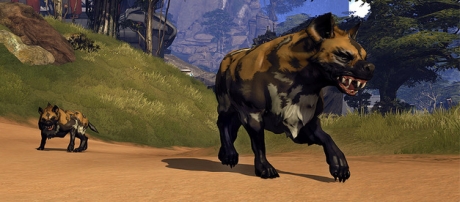
Little is known about these unique and deadly beasts outside of what has been observed by hunters, researchers, and other eyewitness accounts. What scientists have been able to ascertain is that these creatures, in their current state, did not exist before the Melding. They are thought to be the byproduct of canines that had foraged for food in the barren areas that had previously been engulfed within the Melding. Examination of their genetic code shows significant mutation to the point where these feral canines bear little resemblance to the animals that had wandered into the Melding deadlands.
In the wild, these hounds are easily identified by their multicolored pelts of gold, brown and white. They have also been observed to be a social species, congregating in small packs of three to five. Stragglers and lone wolves are assimilated into packs with little distress from the other animals. It’s also been observed that each pack is led by a lone alpha male, who will bare his fangs at the first sign of a challenge to his status, though it is seemingly rare for a hound to challenge another for alpha status.
Although they are constantly on the move and not overtly territorial, hunters have been advised to stay away as these animals are easily provoked. They are known to be incredibly fast, with razor-sharp claws and teeth that can quickly tear the meat off of any bone. When they are stalking larger prey, like a brontodon, the smaller of the canines typically strike at the mammoth’s legs while the larger animals, including the alpha, tear into its hide to bring it down as quickly as possible. The only time that these animals exhibit territorial behavior is when they are feeding. Once they’ve picked the carcass clean, they move on to their next prey.